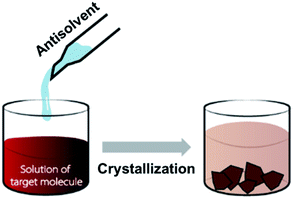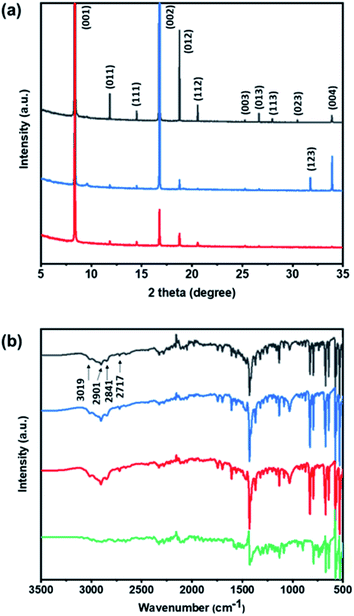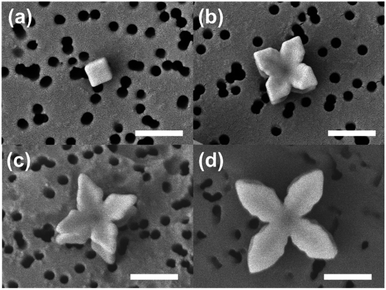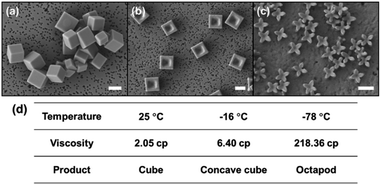 Open Access Article
Open Access ArticleViscosity effect on the strategic kinetic overgrowth of molecular crystals in various morphologies: concave and octapod fullerene crystals†
Kwangjin Song ,
Jin Young Koo and
Hee Cheul Choi
,
Jin Young Koo and
Hee Cheul Choi *
*
Department of Chemistry, Pohang University of Science and Technology (POSTECH), Pohang 37673, Republic of Korea. E-mail: choihc@postech.edu
First published on 14th June 2021
Abstract
A kinetic overgrowth allowing organic molecular crystals in various morphologies is induced by temperature-dependent viscosity change of crystallization solution. By this strategy, concave cube and octapod fullerene C70 crystals were successfully obtained by antisolvent crystallization (ASC). The structural analysis of fullerene C70 crystals indicates that the morphological difference is the result of kinetic processes, which reveals that viscosity, the only variable that can change dynamics of solutes, has a significant influence on determining the morphology of crystals. The effect of solvent viscosity in the stage of crystal growth was investigated through time-dependent control experiments, which led to the proposal of a diffusion rate-based mechanism. Our findings suggest morphology control of organic crystals by diffusion rate control, which is scarcely known compared to inorganic crystals. This strategic method will promote the morphology controls of various organic molecular crystals, and boost the morphology–property relationship study.
Because morphology directly affects the properties of crystals, morphology control of crystals has been one of the major research subjects in chemistry. While the strategies for the morphology control of inorganic metal crystals have been established quite well in the solution phase, primarily through surface chemistry guiding crystallization to occur only on non-passivated crystal planes or through kinetic overgrowth,1–3 the absence of such strategic methods controlling the morphology of organic molecular crystals restricts their potential. Thus, enormous efforts have been devoted to exploring new approaches to control the morphology of molecular crystals through solvent4,5 and temperature controls.6,7
As frequently demonstrated from inorganic metal crystals, kinetic overgrowth can be a prominent method to obtain molecular crystals in various shapes. The kinetic overgrowth induces preferred growth at specific sites resulting in morphologies that are not available thermodynamically, as demonstrated from concave cubes and octapods.8–13 The kinetic overgrowth usually occurs with a concentration gradient around the seed crystals, which can be achieved by regulating the diffusion rate (Vdiff) of solutes and crystal growth rate (Vgrow). Therefore, it is important to understand and develop kinetic overgrowth process for organic molecular crystals, which can correspond to the well-established surface chemistry for inorganic metal crystals.
Considering the importance of concentration gradient near seed crystals for kinetic overgrowth, among various crystallization methods, antisolvent crystallization (ASC) process in which supersaturation and nucleation are induced by the injection of antisolvent to which target molecules have a low solubility (Scheme 1),14–18 is an ideal method for kinetic overgrowth of molecular crystals since it has many variables that can change micro-environment near seed crystals. In addition, fullerenes are good target molecules because obvious results are expected when kinetic product is successfully contrasted to well-known thermodynamic morphologies such as tubes, rods, and even polyhedrons,19–23 as Yang et al. and Ariga et al. showed.24–26 In this case, kinetically favorable fullerene concave cubes could be formed by involving sonication24 and controlling solvent ratio,25,26 and clearly contrasted with fullerene cube crystals. However, the origin and detailed mechanism of these kinetic overgrowths are still veiled, which prevents further application.
 | ||
| Scheme 1 Schematic illustration of traditional ASC process. Target molecules are effectively crystallized via solvation shell mechanism. | ||
In this regard, the influence of temperature on kinetic overgrowth of organic molecular crystals should be investigated not only because of its contribution for thermodynamic versus kinetic reaction control in many branches of chemistry,27–29 but also because it can alter the behavior of molecules significantly during ASC, especially by regulating solution viscosity. Therefore, in this study, we aim to investigate the effect of viscosity upon temperature change for kinetic overgrowth of fullerene crystals. Herein, we show that kinetic overgrowth can be induced by controlling temperature in ASC. Kinetically overgrown fullerene C70 crystals, in concave cube and octapod shapes, are successfully obtained at low temperature, while only cube crystals are obtained at higher temperature. These results originate from increased solution viscosity, which causes slow diffusion of C70 molecules to seed crystals, and consequent kinetic overgrowth. Diffusion rate-based mechanism of inorganic metal nanocrystals is successfully applied to this strategic morphology control.
All the fullerene crystallization has been performed by ASC method. Isopropanol (IPA), an antisolvent, is added to C70 solution in mesitylene to obtain cube-shaped C70 crystals at room temperature. After 3 h, black precipitates have been separated from the solution by filtration for characterization. Well-defined faces, edges, and vertices of C70 cubes are confirmed using a scanning electron microscope (SEM), which agrees well with previous report (Fig. 1a).19 To investigate the effect of growth temperature on the morphology, ASC of C70 has been performed at lower temperature. When the growth temperature is lowered from RT to −16 °C using a refrigerator and −78 °C using dry ice bath, concave cube-shaped and unprecedented octapod C70 crystals are obtained, respectively (Fig. 1b and c). The average sizes of the C70 cube, concave cube, and octapod are 2.0 μm, 2.5 μm, and 1.7 μm, respectively (Fig. S1†). The resulting crystals show a high degree of homogeneity in their morhpologies.
Because these morphologies are well-known kinetically overgrown products for inorganic metal nanocrystals,8–13 we have checked the viscosity of crystallization solution at each temperature, which is directly related to Vdiff of C70 molecules by the Stokes–Einstein equation.30 The apparent viscosity of the solution at the shear rate of 1000 Hz increases from 2.05 cp to 6.40 cp at −16 °C and further to 218.36 cp at −78 °C (Fig. 1d), which indicates dramatic decrease of Vdiff of C70 molecules may occur. From these results, it can be assumed that this morphology difference comes from the slow diffusion of C70 molecules, which is induced by high viscosity at low temperature.
The crystal structures of each product have been examined by powder X-ray diffraction (Fig. 2a). For C70 cube crystals, the overall diffraction pattern including the intense peak from (100) plane with d-spacing of 10.56 Å indicates a simple cubic structure as known from previous results.19 Importantly, the XRD patterns of C70 concave cube and octapod crystals are the same as cube crystals, which implies that the concave cube and octapod morphologies are the results of kinetic crystal overgrowth from cube crystals.25
 | ||
| Fig. 2 (a) X-ray diffraction patterns and (b) Fourier transform infrared spectra of C70 cubes (black), concave cubes (blue), octapods (red), and pristine powder (green). | ||
Furthermore, to examine the effect of solvent inclusion on the crystal morphologies,22 the intercalated molecules have been analyzed using Fourier-transform infrared spectroscopy (Fig. 2b). Four representative peaks of mesitylene (2717, 2841, 2901, 3019 cm−1) are observed equally from all three types of C70 crystals.25 This result suggests that the intercalation of solvent is irrelevant to the morphology decision. The influence of intercalated mesitylene on the rotational motion of fullerene is also investigated by Raman spectroscopy, and no peak shift also indicates that the intercalated mesitylene does not affect the motion of fullerene molecules in crystal lattice (Fig. S2†).25 Therefore, we conclude that morphological diversity of C70 crystals is not originated from common structural difference, but from the crystal overgrowth induced by diffusion rate change induced by viscosity change.
The overall mechanism of morphology control during ASC via viscosity control can be proposed as follows (Fig. 3). When antisolvent is injected into C70 solution of mesitylene, emulsion droplets containing C70 and mesitylene are formed instantaneously, followed by the diffusion of mesitylene out to continuous phase consisted of antisolvent (Fig. 3a).31 As a result, supersaturation and nucleation occur, and seed crystals are formed. To examine if the morphology decision is made at the nucleation stage or growth stage, the seed crystals obtained at 25 °C, −16 °C, and −78 °C are identified by SEM to confirm their cube-shaped morphology (Fig. 3b–d and Fig. S3†). Therefore, the morphological difference must be induced at the crystal growth step, rather than the nucleation step, which is also on the line of seed-mediated kinetic overgrowth mechanism.
After nucleation, the reaction system goes through metastable states, where crystals continue to grow and kinetic overgrowth starts to play. All the mesitylene emulsion droplets are broken and release C70 nucleates. Then, C70 molecules remained in the continuous phase at the stage of nucleation are attached to the nucleates. In this stage, the competition between Vdiff of C70 molecules and Vgrow plays a key role in the determination of crystal morphology, where Vdiff is controlled effectively by viscosity (Fig. 3e). At 25 °C, the viscosity of solution is quite small, so C70 molecules can easily diffuse from the bulk solution to the seed crystals (Vdiff ≫ Vgrow). In this condition, the concentration of C70 around seed crystals is maintained almost same, hence no preferential overgrowth occurs, resulting in seed crystal morphology-retained cube crystals.19 Whereas, C70 molecules cannot diffuse rapidly at −78 °C due to the high viscosity of the solution (Vdiff ≪ Vgrow). In this regime, the concentration gradient of solute around seed crystals is generated because of the fast consumption of C70 molecules near seed crystals with slow refill from the bulk solution. Such a concentration gradient induces preferential attachment of distant solutes to the sites possessing the highest reactivity, vertices for cubic crystals, as known for the inorganic metal crystals.8–13 Eventually, octapod-shaped C70 crystals are formed. The kinetic overgrowth that frequently results in anisotropic crystal growth at specific sites32–34 rather than thermodynamic isotropic growth resulting in simply bigger crystals was supported from time-dependent SEM images of C70 crystals at −78 °C (Fig. 4) showing petals that are preferentially and continuously grown out of cube crystals. In contrast, an isotropic growth only with a size increase from cubic seed has been observed in the case of the growth at 25 °C (Fig. S4 and S5†), which indicates thermodynamic crystal growth at low viscosity.
 | ||
| Fig. 4 Time-dependent SEM images of C70 octapod crystals obtained at −78 °C. Growth time for each image is (a) 0 min, (b) 1 min, (c) 5 min, and (d) 30 min, respectively (scale bar: 1 μm). | ||
To verify if this morphology control is directly related with viscosity change rather than temperature change itself, control experiments using less viscous solvent at the same temperature have been conducted, finding no morphology changes. When acetone is used as antisolvent instead of IPA, no morphological change is observed even at the growth temperature of −78 °C, (Fig. 5 and S6†) and this result owes to the low viscosity of acetone even at low temperature.35 In other words, the addition of acetone to mesitylene solution does not cause a dramatic viscosity change, which implies the importance of the selection of good solvent and antisolvent for the successful morphology control by ASC process. On the other hand, the use of other alcohols (ethanol, 1-propanol, and 1-butanol having viscosity of 5.26, 6.52, and 7.53 cp at −16 °C and 30.0, 79.8, and 132.0 cp at −78 °C, respectively) show clear kinetic overgrowth at low temperature (Fig. S7†). Other than the viscosity change inducing morphology control, there is another important property change, i.e. solubility change upon temperature change (Fig. S8†) to be considered, which requires further studies in the future.
 | ||
| Fig. 5 C70 cubes prepared using acetone as antisolvent at (a) 25 °C, (b) −16 °C, and (c) −78 °C (scale bar: 2 μm). | ||
Conclusions
We reveal that kinetic overgrowth is an effective route to obtain fullerene crystals in various morphologies, concave cube and octapod through kinetic overgrowth. The kinetic overgrowth can be induced by viscosity change of crystallization solution, which is readily available by temperature change. Finding other ways to modulate viscosity of crystallization than temperature change would be the key for the popular usage of kinetic overgrowth method. We are also currently working on the application of kinetic overgrowth to other organic molecules to check its versatility. This work provides new insights into the role of temperature for the morphology control of fullerene crystals by ASC, allowing kinetic overgrowth as a facile way to obtain molecular crystals in various shapes.Experimental section
Materials
Fullerene C70 (MTR LTD, 98+%), mesitylene (Alfa Aesar, 98+%), isopropanol (Sigam Aldrich, anhydrous, 99.5%), ethanol (Samchun, anhydrous, 99.9%), 1-propanol (Sigma Aldrich, for HPLC, ≥99%), 1-butanol (Sigma Aldrich, 99.8%, HPLC grade), and acetone (Sigma Aldrich, for HPLC, ≥99.9%) were purchased and used without further purification.Preparation of cube-, concave cube-, and octapod-shaped C70 crystals using IPA
10 mg of C70 powder was dissolved in 10 mL of mesitylene, followed by sonication for 30 min. Pure C70 solution without any impurities and undissolved C70 powder was obtained by filtration, and 3 mL of this solution was diluted by adding 7 mL of mesitylene. Cube-shaped fullerene C70 crystals were synthesized by adding 4 mL of IPA to 1 mL of diluted C70 solution. The mixture was shaken by hand for 5 s and kept at 25 °C for designated times. Concave cube- and octapod-shaped fullerene C70 crystals were obtained at lower temperature of −16 °C and −78 °C, while other conditions are identical. C70/mesitylene solution was cooled to −16 °C and IPA cooled to −16 °C and −78 °C was added into the C70/mesitylene solution for concave cube and octapod, then mixed vigorously by handshaking and placed in refrigerator and dry ice/acetone bath to keep the reaction temperature at −16 °C and −78 °C, respectively. Note that the crystallization solution at −78 °C is stable despite the high melting point (−45 °C) of mesitylene owing to the melting point depression upon the addition of antisolvent. All resulting crystals were collected via filtration.Testing acetone as antisolvent
1 mL of acetone was injected to 1 mL of diluted C70 solution in mesitylene, followed by hand-shaking for 5 s at various temperature (25 °C, −16 °C, −78 °C). The mixtures were kept at each temperature for 3 h, and resulting cubic crystals were collected by filtration.Testing other alcohols as antisolvent
4 mL of ethanol, 1-propanol, and 1-butanol were injected to 1 mL C70 solution in mesitylene with different concentration, followed by hand-shaking for 5 s at various temperature (25 °C, −16 °C, −78 °C). The concentration of C70 solution is 0.2, 0.3, and 0.6 mg mL−1 when using ethanol, 1-propanol and 1-butanol, respectively. The mixtures were kept at each temperature, and resulting crystals were collected via filtration.Characterizations
Scanning electron microscope (SEM) images were obtained using a JEOL JSM-7401F. Viscosity measurements were performed using a DHR-3 rheometer, with the shear rate of 1000 Hz. Used upper geometry and lower geometry were 25 mm aluminum flat plate and 25 mm stainless steel, stepped lower ETC plate, respectively. Note that the measurement of zero shear viscosity, which describes a plateau viscosity value of material was impossible because of the escape of solution from sample holder at low shear rate. Structural analysis of C70 cubes, concave cubes, and octapods was achieved by attenuated total reflectance infrared (ATR-IR) spectroscopy (Thermo Scientific, Nicolet iS50) using diamond crystals, and Raman spectroscopy (WITECH Alpha 300R). X-ray diffraction (XRD) patterns were obtained at the 5D beamline of Pohang Accelerator Laboratory (PAL, Pohang, Korea).Conflicts of interest
There are no conflicts to declare.Acknowledgements
This work was supported by Veteran Researcher Grant (no. 2019R1A2C2004259) and Basic Science Research Program (no. 2021R1C1C2006705) through the National Research Foundation of Korea (NRF) and Samsung Electronics. PXRD measurements were performed at the 5D beamline of PAL, and SEM images were obtained at National Institute for Nanomaterials Technology (NINT). Viscosity measurements were fulfilled at Korea Institute of Science and Technology (KIST) Jeonbuk Institute of Advanced Composite Materials.References
- D. F. Zhang, H. Zhang, L. Guo, K. Zheng, X. D. Han and Z. Zhang, J. Mater. Chem., 2009, 19, 5220–5225 RSC
.
- J. Pan, G. Liu, G. Q. M. Lu and H.-M. Cheng, Angew. Chem., Int. Ed., 2011, 50, 2133–2137 CrossRef CAS PubMed
.
- J. Lin, W. Hao, Y. Shang, X. Wang, D. Qiu, G. Ma, C. Chen, S. Li and L. Guo, Small, 2018, 74, 1703274 CrossRef
.
- X. Zhang, C. Dong, J. Zapien, S. Ismathullakhan, Z. Kang, J. Jie, X. Zhang, J. Chang, C.-S. Lee and S.-T. Lee, Angew. Chem., Int. Ed., 2009, 48, 9121–9123 CrossRef CAS
.
- L. Huang, Q. Liao, Q. Shi, H. Fu, J. Ma and J. Yao, J. Mater. Chem., 2010, 20, 159–166 RSC
.
- X. Zhang, X. Zhang, K. Zou, C. S. Lee and S. T. Lee, J. Am. Chem. Soc., 2007, 129, 3527–3532 CrossRef CAS PubMed
.
- A. Masuhara, Z. Tan, H. Kasai, H. Nakanishi and H. Oikawa, Jpn. J. Appl. Phys., 2009, 48, 050206 CrossRef
.
- T. Herricks, J. Chen and Y. Xia, Nano Lett., 2004, 4, 2367–2371 CrossRef CAS
.
- X. Huang, Z. Zhao, J. Fan, Y. Tan and N. Zheng, J. Am. Chem. Soc., 2011, 133, 4718–4721 CrossRef CAS PubMed
.
- M. Jin, H. Zhang, Z. Xie and Y. Xia, Angew. Chem., Int. Ed., 2011, 50, 7850–7854 CrossRef CAS PubMed
.
- H. Khurshid, W. Li, S. Chandra, M. H. Phan, G. C. Hadjipanayis, P. Mukherjee and H. Srikanth, Nanoscale, 2013, 5, 7942–7952 RSC
.
- B. Lim and Y. Xia, Angew. Chem., Int. Ed., 2011, 50, 76–85 CrossRef CAS PubMed
.
- A. R. Poerwoprajitno, L. Gloag, S. Cheong, J. J. Gooding and R. D. Tilley, Nanoscale, 2019, 11, 18995–19011 RSC
.
- H. X. Ji, J. S. Hu, Q. X. Tang, W. G. Song, C. R. Wang, W. P. Hu, L. J. Wan and S. T. Lee, J. Phys. Chem. C, 2007, 111, 10498–10502 CrossRef CAS
.
- S. Mostafa Nowee, A. Abbas and J. A. Romagnoli, Chem. Eng. Sci., 2008, 63, 5457–5467 CrossRef CAS
.
- W. Li, C. Zhao, B. Zou, X. Zhang, J. Yu, X. Zhang and J. Jie, CrystEngComm, 2012, 14, 8124–8127 RSC
.
- P. MacFhionnghaile, V. Svoboda, J. McGinty, A. Nordon and J. Sefcik, Cryst. Growth Des., 2017, 17, 2611–2621 CrossRef CAS
.
- S. Zheng, N. T. Cuong, S. Okada, T. Xu, W. Shen, X. Lu and K. Tsukagoshi, Chem. Mater., 2018, 30, 7146–7153 CrossRef CAS
.
- C. Park, E. Yoon, M. Kawano, T. Joo and H. C. Choi, Angew. Chem., Int. Ed., 2010, 49, 9670–9675 CrossRef CAS PubMed
.
- L. K. Shrestha, Y. Yamauchi, J. P. Hill, K. Miyazawa and K. Ariga, J. Am. Chem. Soc., 2013, 135, 586–589 CrossRef CAS PubMed
.
- J. Kim, C. Park and H. C. Choi, Chem. Mater., 2015, 27, 2408–2413 CrossRef CAS
.
- S. Zheng and X. Lu, RSC Adv., 2015, 5, 38202–38208 RSC
.
- N. Chen, Y. Hu, T. Xu and X. Lu, ACS Appl. Electron. Mater., 2020, 2, 2010–2016 CrossRef CAS
.
- Y. Xu, X. Chen, F. Liu, X. Chen, J. Guo and S. Yang, Mater. Horiz., 2014, 1, 411 RSC
.
- P. Bairi, K. Minami, J. P. Hill, K. Ariga and L. K. Shrestha, ACS Nano, 2017, 11, 7790–7796 CrossRef CAS PubMed
.
- J. Wu, X. Zhu, Y. Guan, Y. Wang, F. Jin, R. Guan, F. Liu, M. Chen, Y. Tian and S. Yang, Angew. Chem., Int. Ed., 2019, 58, 11350–11354 CrossRef CAS PubMed
.
- Y. Wang, J. He, C. Liu, W. H. Chong and H. Chen, Angew. Chem., Int. Ed., 2015, 54, 2022–2051 CrossRef CAS PubMed
.
- A. K. Cheetham, G. Kieslich and H. H.-M. Yeung, Acc. Chem. Res., 2018, 51, 659–667 CrossRef CAS PubMed
.
- S. R. Marsden, L. Mestrom, D. G. G. McMillan and U. Hanefeld, ChemCatChem, 2020, 12, 426–437 CrossRef CAS
.
- A. Einstein, Ann. Phys., 1905, 322, 549–560 CrossRef
.
- Y. Park, K. Song and H. C. Choi, CrystEngComm, 2021, 23, 777–782 RSC
.
- Z. Lou, B. Huang, X. Qin, X. Zhang, H. Cheng, Y. Liu, S. Wang, J. Wang and Y. Dai, Chem. Commun., 2012, 48, 3488 RSC
.
- Y. Yin and A. P. Alivisatos, Nature, 2005, 437, 664–670 CrossRef CAS PubMed
.
- H. Dong, C. Zhang, F. Shu, C. Zou, Y. Yan, J. Yao and Y. S. Zhao, Adv. Mater., 2021, 33, 2100484 CrossRef CAS PubMed
.
- E. H. Archibald and W. Ure, J. Chem. Soc., Trans., 1924, 125, 726–731 RSC
.
Footnote |
| † Electronic supplementary information (ESI) available. See DOI: 10.1039/d1ra02924j |
| This journal is © The Royal Society of Chemistry 2021 |


